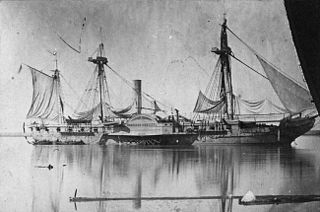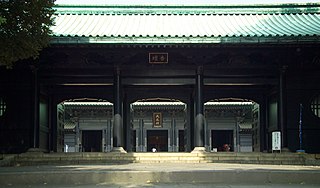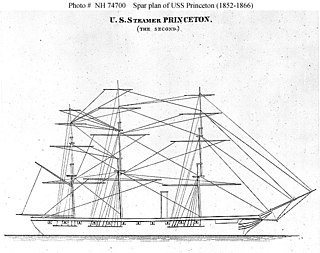
Convention of Kanagawa or Kanagawa Treaty, Japan–US Treaty of Peace and Amity was a treaty signed between the United States and the Tokugawa shogunate on March 31, 1854. Signed under threat of force, it effectively meant the end of Japan's 220-year-old policy of national seclusion (sakoku) by opening the ports of Shimoda and Hakodate to American vessels. It also ensured the safety of American castaways and established the position of an American consul in Japan. The treaty precipitated the signing of similar treaties establishing diplomatic relations with other Western powers.

Matthew Calbraith Perry was a commodore of the United States Navy who commanded ships in several wars, including the War of 1812 and the Mexican–American War (1846–1848). He played a leading role in the opening of Japan to the West with the Convention of Kanagawa in 1854.

USS Vincennes (1826) was a 703-ton Boston-class sloop of war in the United States Navy from 1826 to 1865. During her service, Vincennes patrolled the Pacific, explored the Antarctic, and blockaded the Confederate Gulf coast in the Civil War. Named for the Revolutionary War Battle of Vincennes, she was the first U.S. warship to circumnavigate the globe.

The first USS Powhatan was a sidewheel steam frigate in the United States Navy during the American Civil War. She was named for Powhatan, a Native American chief of eastern Virginia. She was one of the last, and largest, of the United States Navy's paddle frigates.
Joel Abbot was a U.S. naval officer who served notably in the War of 1812, and commanded a ship during Commodore Perry's 1853-1854 visit to Japan. Commodore Joel Abbot was Admiral Matthew C. Perry's second in command when they opened Japan in 1853-1854.

Kaei (嘉永) was a Japanese era name after Kōka and before Ansei. This period spanned the years from February 1848 through November 1854. The reigning emperor was Kōmei-tennō (孝明天皇).

The first Vandalia was an 18-gun sloop-of-war in the United States Navy during the Second Seminole War and the American Civil War. She was named for the city of Vandalia, Illinois.

USS Mississippi, a paddle frigate, was the first ship of the United States Navy to bear that name. She was named for the Mississippi River. Her sister ship was Missouri. Her keel was laid down by the Philadelphia Navy Yard in 1839; built under the personal supervision of Commodore Matthew Perry. She was commissioned on 22 December 1841, with Captain W. D. Salter in command and launched several weeks later.
USS Germantown was a United States Navy sloop-of-war in commission for various periods between 1847 and 1860. She saw service in the Mexican–American War in 1847–1848 and during peacetime operated in the Caribbean, in the Atlantic Ocean off Africa and South America, and in East Asia. Scuttled at the outbreak of the American Civil War in 1861, she was captured and refloated by the Confederate States of America and placed in service with the Confederate States Navy as the floating battery CSS Germantown before again being scuttled in 1862.

The East India Squadron, or East Indies Squadron, was a squadron of American ships which existed in the nineteenth century, it focused on protecting American interests in the Far East while the Pacific Squadron concentrated on the western coasts of the Americas and in the South Pacific Ocean. Part of the duties of this squadron was serving with the Yangtze River Patrol in China. The East India Squadron was established in 1835 and existed until it became part of the Asiatic Squadron in 1868.

The North Pacific Exploring and Surveying Expedition, also known as the Rodgers-Ringgold Expedition was a United States scientific and exploring project from 1853 to 1856.

The Perry Expedition was a diplomatic and military expedition to the Tokugawa Shogunate, involving two separate voyages by warships of the United States Navy which took place during 1853–54. The goals of this expedition included exploration, surveying, and the establishment of diplomatic relations and negotiation of trade agreements with various nations of the region; opening contact with the government of Japan was considered a top priority of the expedition, and was one of the key reasons for its inception.

Hayashi Akira was an Edo period scholar-diplomat serving the Tokugawa shogunate in a variety of roles similar to those performed by serial Hayashi clan neo-Confucianists since the time of Tokugawa Ieyasu. He was the hereditary Daigaku-no-kami descendant of Hayashi Razan, the first head of the Tokugawa shogunate's neo-Confucian academy in Edo, the Shōhei-kō.

USS Princeton (1851) was a large 1,370-ton steamer with powerful guns, some of whose timbers were those from the first USS Princeton, the U.S. Navy's first screw steam warship.

Hayashi Gakusai, formerly Hayashi Noboru, was a neo-Confucian scholar and a bakufu official in the late Tokugawa shogunate.

Sō Yoshiyori was a Sō clan daimyō of the island domain of Tsushima at the end of Japan's Edo period.

Cadwalader Ringgold was an officer in the United States Navy who served in the United States Exploring Expedition, later headed an expedition to the Northwest and, after initially retiring, returned to service during the Civil War.
Jeddo and Yedo or Yeddo are anglicisations referring to the town and port of Edo, Japan and the adjacent large bay, and generally to the ruling shogunate of Japan during the 1850s and 1860s, which was based in Edo. After 1868, Edo was renamed as Tokyo. The names Jeddo and Yedo became commonly used by English-speaking people in the mid-1800s, following the expedition of Commodore Matthew Perry, which resulted in the opening of Japan to trade. Neither name is in common use today, as a name of reference for Edo, or the bay, or the Tokugawa shogunate associated with Edo. Following the Perry Expedition, there was an increase in popular interest in Japan, and a number of American communities were named Jeddo or Yeddo.
The Reverend Prof. George Jones was a minister of the Episcopal Church, United States Navy chaplain, academic, and writer.
This article encompasses the 1850s Pacific typhoon seasons. The list is very incomplete; information on early typhoon seasons is patchy and relies heavily on individual observations of travellers and ships. There were no comprehensive records kept by a central organisation at this early time.













